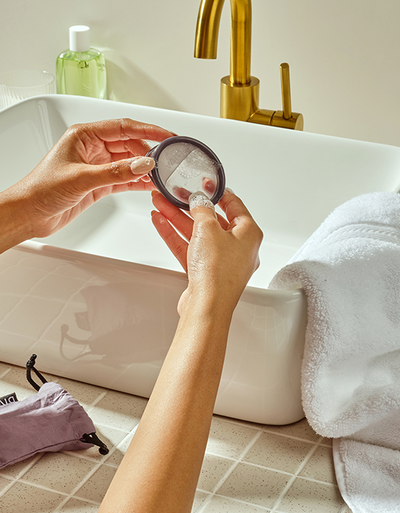In this article /
J'avais seize ans lorsque j'ai vécu ma première rupture. Assis à la table de ma cuisine en train de faire mes devoirs, j'ai été frappé par une sensation perçante dans le bas de mon ventre. Je me suis immédiatement plié en deux et j'ai appelé ma mère. Quand j'ai décrit ce que je ressentais – une douleur abdominale si intense que je pouvais à peine bouger ou parler – elle savait ce qui se passait. C'était une rupture d'un kyste de l'ovaire.
Pour ma sœur et moi, notre symptôme le plus important était les règles irrégulières. Ma sœur a perdu ses règles pendant des mois à plusieurs reprises, et il n'était pas rare que je saute un mois ou deux, surtout si j'étais stressée ou si je voyageais. Jusqu'à ma première rupture, je pensais que c'était une partie normale des menstruations.
Mais le problème n’a pas été résolu et, au moment où j’ai arrêté de prendre la pilule contraceptive, un an et demi plus tard, mes hormones se sont détraquées. Mon système endocrinien était resté assis et détendu pendant si longtemps ; maintenant que le contrôle des naissances n’avait plus les rênes, il ne savait plus quoi faire. Mes règles ont disparu pendant sept mois.
Après avoir passé le cap des six mois et confirmé que je n'étais pas enceinte, j'ai mis en place une consultation de santé en ligne car mon médecin de famille était à la retraite. Le nouveau médecin à qui j'ai parlé a ordonné une autre analyse de sang. Mes premières règles en 205 jours sont arrivées la veille de mon rendez-vous.
Le test a montré les mêmes résultats que le premier et comme mes règles étaient de retour, le médecin m'a répété qu'il ne serait pas nécessaire de les évaluer davantage. Mais même si mes règles revenaient, d’autres symptômes s’aggravaient. J'avais des ruptures plus fréquentes (une d'elles m'a même fait m'évanouir), je n'arrivais pas à me débarrasser d'une prise de poids tenace, les poils de moustache poussaient plus vite que jamais et mon anxiété était à un niveau record (tous des symptômes révélateurs de SOPK !). J’ai été balayé comme si tous ces symptômes étaient aussi minimes qu’un simple rhume. Je savais que si j'exprimais à nouveau mes inquiétudes, on me dirait seulement de reprendre le contrôle des naissances.
Après que l'épouse de Tom Sullivan, Rachael Sullivan, ait souffert pendant des années du SOPK et ait eu du mal à recevoir des soins médicaux suffisants, Tom a commencé à se renseigner sur les phases du cycle menstruel et à cuisiner des repas pour soutenir les niveaux d'hormones de Rachael. Ils m'ont non seulement montré qu'il était possible d'aborder mon SOPK avec connaissance plutôt qu'avec peur, mais aussi qu'avec un régime alimentaire approprié et de l'exercice, je pouvais améliorer mes symptômes sans contraceptifs hormonaux.
Après seulement quelques mois de suivi de mes phases et d’intégration des aliments et exercices recommandés, j’ai remarqué des améliorations significatives. Ma peau était claire et éclatante. Je n'étais pas terriblement ballonné, fatigué ou anxieux tout le temps. Et plus important encore, maintenant mes règles arrivent mois après mois pour la première fois de ma vie d’adulte.
Cela dit, il est important de défendre vos intérêts et de parler à un professionnel de la santé si vous pensez souffrir du SOPK. J'ai la chance de pouvoir gérer moi-même mon état maintenant, mais dans certains cas, une intervention médicale, comme l'ablation chirurgicale des kystes, est nécessaire. L’essentiel est de rechercher les bonnes ressources et de parler ouvertement à votre communauté, car vous n’êtes certainement pas seul.
La plupart des médecins vous diront que la contraception est le seul « remède » contre le SOPK, mais elle a pour effet secondaire de masquer les symptômes. Aucune des causes sous-jacentes (telles que l’augmentation des androgènes et la résistance à l’insuline) n’est résolue et, d’après mon expérience, elles risquent de s’aggraver lorsque le contrôle des naissances s’arrête. Mais avec le soutien approprié, il est possible d’adopter une approche holistique du traitement du SOPK et de ramener votre corps à une harmonie naturelle et saine.
*Avertissement : Parce que chaque corps est unique, nous vous recommandons toujours de travailler avec un professionnel de la santé pour déterminer le meilleur traitement pour votre corps.
Symptômes courants de rupture du kyste ovarien
Le syndrome des ovaires polykystiques (SOPK) touche 1 personne menstruée sur 10 et est généralement transmis par les gènes. Ma mère a eu des ruptures de kystes ovariens qui l'ont conduite à deux reprises à l'hôpital. Le SOPK peut se présenter avec ou sans kystes ovariens et est notoirement sous-diagnostiqué. En effet, les symptômes varient considérablement et peuvent facilement être confondus avec d’autres affections ou considérés comme une partie « normale » de la menstruation. 50 % des personnes atteintes du SOPK sont diagnostiquées tard dans la vie ou pas du tout.Pour ma sœur et moi, notre symptôme le plus important était les règles irrégulières. Ma sœur a perdu ses règles pendant des mois à plusieurs reprises, et il n'était pas rare que je saute un mois ou deux, surtout si j'étais stressée ou si je voyageais. Jusqu'à ma première rupture, je pensais que c'était une partie normale des menstruations.
Combien de temps dure la douleur d'un kyste ovarien rompu ?
Lorsque j'ai raconté ce qui s'était passé à mon médecin, il m'a demandé combien de temps durait la douleur et si j'avais ressenti d'autres symptômes depuis. Heureusement, la douleur intense n’a duré qu’une dizaine de minutes et, à part quelques crampes résiduelles, je me suis senti bien par la suite. Il m'a dit qu'il n'était pas nécessaire de réserver une échographie ou une prise de sang pour un diagnostic formel.Quel est le meilleur moyen de contraception pour le SOPK ?
Quelques années plus tard, j'ai voulu me mettre au contrôle des naissances. J'ai de nouveau exprimé mon inquiétude concernant le SOPK à mon médecin, craignant que la pilule ne fasse plus de mal que de bien. Il a ordonné une prise de sang pour vérifier tout déséquilibre hormonal et, sans surprise, mon taux de testostérone était élevé. Il a dit que la pilule aiderait – et pendant un moment, ce fut le cas. Fini le temps des règles inattendues, des sautes hormonales et des ruptures de kystes.Mais le problème n’a pas été résolu et, au moment où j’ai arrêté de prendre la pilule contraceptive, un an et demi plus tard, mes hormones se sont détraquées. Mon système endocrinien était resté assis et détendu pendant si longtemps ; maintenant que le contrôle des naissances n’avait plus les rênes, il ne savait plus quoi faire. Mes règles ont disparu pendant sept mois.
Après avoir passé le cap des six mois et confirmé que je n'étais pas enceinte, j'ai mis en place une consultation de santé en ligne car mon médecin de famille était à la retraite. Le nouveau médecin à qui j'ai parlé a ordonné une autre analyse de sang. Mes premières règles en 205 jours sont arrivées la veille de mon rendez-vous.
Le test a montré les mêmes résultats que le premier et comme mes règles étaient de retour, le médecin m'a répété qu'il ne serait pas nécessaire de les évaluer davantage. Mais même si mes règles revenaient, d’autres symptômes s’aggravaient. J'avais des ruptures plus fréquentes (une d'elles m'a même fait m'évanouir), je n'arrivais pas à me débarrasser d'une prise de poids tenace, les poils de moustache poussaient plus vite que jamais et mon anxiété était à un niveau record (tous des symptômes révélateurs de SOPK !). J’ai été balayé comme si tous ces symptômes étaient aussi minimes qu’un simple rhume. Je savais que si j'exprimais à nouveau mes inquiétudes, on me dirait seulement de reprendre le contrôle des naissances.
Essayer un régime de résistance à l'insuline
Puis je suis tombée sur le compte Instagram Meals She Eats et ma vie a changé.Après que l'épouse de Tom Sullivan, Rachael Sullivan, ait souffert pendant des années du SOPK et ait eu du mal à recevoir des soins médicaux suffisants, Tom a commencé à se renseigner sur les phases du cycle menstruel et à cuisiner des repas pour soutenir les niveaux d'hormones de Rachael. Ils m'ont non seulement montré qu'il était possible d'aborder mon SOPK avec connaissance plutôt qu'avec peur, mais aussi qu'avec un régime alimentaire approprié et de l'exercice, je pouvais améliorer mes symptômes sans contraceptifs hormonaux.
Après seulement quelques mois de suivi de mes phases et d’intégration des aliments et exercices recommandés, j’ai remarqué des améliorations significatives. Ma peau était claire et éclatante. Je n'étais pas terriblement ballonné, fatigué ou anxieux tout le temps. Et plus important encore, maintenant mes règles arrivent mois après mois pour la première fois de ma vie d’adulte.
Cela dit, il est important de défendre vos intérêts et de parler à un professionnel de la santé si vous pensez souffrir du SOPK. J'ai la chance de pouvoir gérer moi-même mon état maintenant, mais dans certains cas, une intervention médicale, comme l'ablation chirurgicale des kystes, est nécessaire. L’essentiel est de rechercher les bonnes ressources et de parler ouvertement à votre communauté, car vous n’êtes certainement pas seul.
La plupart des médecins vous diront que la contraception est le seul « remède » contre le SOPK, mais elle a pour effet secondaire de masquer les symptômes. Aucune des causes sous-jacentes (telles que l’augmentation des androgènes et la résistance à l’insuline) n’est résolue et, d’après mon expérience, elles risquent de s’aggraver lorsque le contrôle des naissances s’arrête. Mais avec le soutien approprié, il est possible d’adopter une approche holistique du traitement du SOPK et de ramener votre corps à une harmonie naturelle et saine.
*Avertissement : Parce que chaque corps est unique, nous vous recommandons toujours de travailler avec un professionnel de la santé pour déterminer le meilleur traitement pour votre corps.











